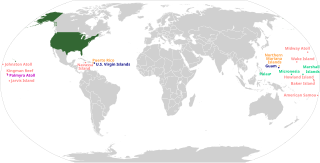A referendum is a direct and universal vote in which an entire electorate is invited to vote on a particular proposal and can have nationwide or local forms. This may result in the adoption of a new policy or specific law. In some countries, it is synonymous with a plebiscite or a vote on a ballot question.

"51st state", in post-1959 American political discourse, is a phrase that refers to areas or locales that are – seriously or facetiously – considered candidates for U.S. statehood, joining the 50 states that presently compose the United States. The phrase has been applied to external territories as well as parts of existing states which would be admitted as separate states in their own right.

An independence referendum was held in the Faroe Islands on 14 September 1946.

General elections were held in Guam on November 7, 2006 in order to elect the Governor, all 15 seats in the Legislature and the federal delegate. There was also a double referendum on legalise slot machines at racing tracks and raising the age at which citizens could purchase and consume alcohol to 21.

The Puerto Rico Democracy Act is a bill to provide for a federally sanctioned self-determination process for the people of Puerto Rico.

The statehood movement in Puerto Rico aims to make Puerto Rico a state of the United States. Five referendums have been held on the topic, most recently in 2017. The population of Puerto Rico in 2015 was over three million people and larger than that of 21 states.

A referendum on the islands' status was held in the Federated States of Micronesia on 21 June 1983. Voters were asked two questions. The first was on whether they approved of the Compact of Free Association between the FSM and the United States. The second was what their preference was if Free Association was rejected. Voters were presented with the option of independence or an alternative which they had to fill in on the ballot form.
A referendum on the political status of Puerto Rico was held in Puerto Rico on November 6, 2012. It was the fourth referendum on status to be held in Puerto Rico. Puerto Rico has been an unincorporated territory of the United States since the Spanish–American War in 1898.
A referendum on union with the Northern Mariana Islands was held in Guam on 4 November 1969. The proposal was rejected by 58% of voters due to fears about an increase in taxation. Despite the result, a similar referendum was held in the Northern Mariana Islands on 9 November in which 61% of voters supported union with Guam.
A referendum on the territory's status was held in Guam on 4 September 1976. Voters were presented with a range of options, with "improved status quo" receiving the support of 58%.
A two-part referendum was held in Guam on 4 August 1979. A proposed new constitution was rejected by 82% of voters, whilst a law introducing the death penalty was rejected by 53% of voters. In August 1987 a referendum was held on another proposed constitution, with each chapter voted on separately. Two chapters were rejected by voters, resulting in a second referendum in November in which both were approved.
A referendum on the territory's status was held in Guam on 30 January 1982. Although the option of becoming a US commonwealth received the most votes, it did not achieve a majority. As a result, a second referendum was held in September with only two options.
A referendum on introducing balanced budgets was held in Guam on 1 November 1986. Although more voters voted "yes" than "no", the Santos Amendment had required that the referendum required at least 50% of all votes in favour to pass. As a result, the proposal was rejected.

An unofficial referendum on integration with Guam was held in the Northern Mariana Islands on 27 October 1963. Although the proposal was approved by voters, the islands were not integrated.

A referendum on the islands' status was held in the Northern Mariana Islands on 5 February 1961. Although 65% of voters supported integration with Guam, the United States did not integrate the islands.

A referendum on the islands' status was held in the Northern Mariana Islands on 9 November 1969. For the fourth time since 1958 a majority of voters supported integration with Guam. However, a referendum held in Guam on 4 November on integration with the Northern Mariana Islands had been rejected by 58% of Guamanian voters.

A referendum on becoming a US commonwealth was held in the Northern Mariana Islands on 17 June 1975. The proposal was approved by 79% of voters. As a result, the United States Congress approved the change of status on 24 March 1976.
A referendum on legalising slot machines at greyhound racetracks was held in Guam on 5 January 2008. The proposal was rejected by 63% of voters.

A status referendum was held in the United States Virgin Islands on 11 October 1993. After the United States Congress modified the Revised Organic Act of the Virgin Islands to allow a vote on the status of the islands, a vote was scheduled for 1989. It was delayed several times until 1993, when voters were offered the options of integration into the United States, becoming a United States territory or independence.

A series of referendums on the proposed constitution of Australia were held between 2 June 1898 and 31 July 1900 in the six colonies that were to become the states of the Commonwealth of Australia. The first four referendums were held in New South Wales, South Australia, Tasmania and Victoria in June 1898. Although all four saw a majority vote in favour, the majority in New South Wales was insufficient. Knowledge of the result in New South Wales led to low voter turnout in South Australia.









